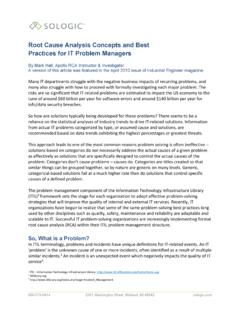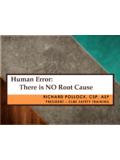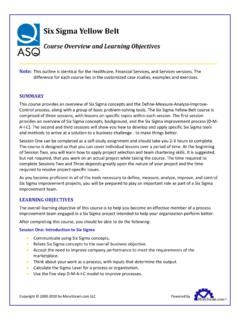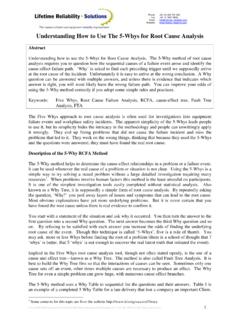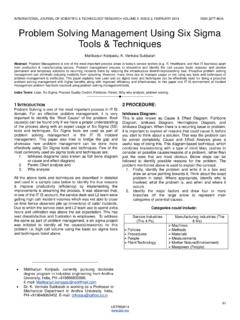Transcription of news brief - Home - Centers for Medicare & …
1 1news briefTransforming the lives of nursing home residents through continuous attention to quality of care and quality of lifeVOLUME 1 / 2013 WHAT IS QAPI?QAPI is the merger of two comple-mentary approaches to quality management, Quality Assurance (QA) and Performance Improvement (PI). QA and PI combine to form QAPI, a comprehensive approach to ensuring high quality care. Both involve seeking and using informa-tion, but they differ in key ways: nQA is a process of meeting quality standards and assuring that care reaches an acceptable level. Nursing homes typically set QA thresholds to comply with regulations. They may also create standards that go beyond regulations. QA is a reactive, retrospective effort to examine why a facility failed to meet certain standards. QA activities do improve quality, but efforts frequently end once the standard is met. nPI (also called Quality Improvement - QI) is a proactive and continuous study of processes with the intent to prevent or decrease the likelihood of problems by identifying areas of opportunity and testing new approaches to fix underlying causes of persistent/systemic problems.
2 PI in nursing homes aims to improve processes involved in health care delivery and resident quality of life. PI can make good quality even ELEMENTS OF QAPI1. Design and Scope2. Governance and Leadership3. Feedback, Data Systems and Monitoring4. Performance Improvement Projects (PIPS)5. Systematic Analysis and Systemic ActionThe articles in this issue introduce you to some of the important aspects of each of the 5 1 - Design and Scope of QAPI in your FacilityInvolving All Staff in QAPIFor successful implementation, QAPI cannot be imposed from the top down. Rather, all levels of staff in nursing homes must be involved in planning and improving systems and processes in order to get effective results. Direct care staff have valuable and unique input which are vital to the success of performance improvement. It s easy to say all levels of staff should be involved, but harder to put into practice. All staff must know they contribute as individuals to the big picture: the successful achievement of the resident s goals for quality of life and quality of care.
3 Involving all levels of staff in QAPI can be challenging. I don t have time to leave the floor is a commonly heard sentiment from nursing assistants in response to a request to attend meetings. Organizations need to have adequate levels of staffing in order to cover the absence of a direct care staff member to attend meetings. This is even more of a challenge in homes that are facing shortages of staff. Transforming the lives of nursing home residents through continuous attention to quality of care and quality of lifeQAPI news brief2 Nursing assistants may not be accustomed to voicing their opinions in the company of directors, supervisors, physicians, and other senior nursing home staff. Let direct care staff know that their experiences with the residents are invaluable to the QAPI process. Their hands-on knowledge of the resident and the day-to-day processes of the nursing home are necessary to the QAPI discussion and 2 Governance and LeadershipHow to Engage Residents and Families in QAPIR esidents should have control over their lives, influence decisions which affect them, and know that their opinions and preferences matter.
4 The autonomy, individuality, and dignity inherent in this goal are all part of quality of life. The opinions and priorities of individual residents and family members should guide QAPI. Residents and families can identify quality of life and care issues important to them, and provide feedback on their experiences. Residents and families may also have structural roles in QAPI they can serve on performance improvement project (PIP) teams and Steering Committees. Residents and families have unique perspectives and can facilitate communication with staff and bring in new using your Resident Council as a source of input for QAPI. The following questions may be helpful as you consider how to involve residents and families in QAPI: nHow do you regularly ask for feedback from residents and families? Remember that QAPI Element 3 Feedback, Data Systems, and Monitoring requires that some of your data are derived from feedback from residents and families. nDo you investigate resident and family complaints and generate action plans if validated?
5 NHow do you create a climate where residents and families are comfortable raising issues? nDo you have a resident and/ or family council that can help individuals speak in a shared voice to effect change? nDo you address the concerns raised in resident and family council? nDo you have, or would you consider having a resident and/ or family member on your Quality steering committee?Creating an Environment for QAPIFor QAPI to thrive, nursing homes need to create an environment that balances safety and accountability with fairness and homes should facilitate communication by adopting a nonpunitive response to medical errors and near misses. They should not adopt a blameless system where no one is held accountable for reckless or careless behavior or intentional rule breaking. Rather, employees should feel comfortable coming forward with useful information in the interest of system 3 Feedback, Data Systems and MonitoringMaking Data MeaningfulHow do you know if you are doing well?
6 Without a baseline or point of comparison, it is hard to judge your own performance. A strong approach to quality management, such as QAPI, uses performance indicators to monitor a wide range of care processes and outcomes. Then it reviews findings against benchmarks or targets the facility has established for the lives of nursing home residents through continuous attention to quality of care and quality of lifeQAPI news brief3 Benchmark refers to a standard against which other things can be measured or judged. You can use external results that represent best practices and performances, often around quality, time, and cost as the standards for setting is the process of comparing a set of results to these best practices and performances. For example: nA benchmark for physical restraints in nursing homes might be zero, as many homes have achieved this rate. nA benchmark for consistent nursing assistant assignment has been set by the Advancing Excellence in America s Nursing Homes campaign as no more than 8 nursing assistants for one resident over a four week period, since organizations that have focused on consistent assignment have been able to achieve this sources for benchmarks are Nursing home Compare and Advancing Excellence.
7 Other sources are literature from researchers and data analysis from industries that have similar processes, and data from nursing home organizations that have been recognized for leadership in a specific process area. A target refers to an internal goal that refers to a specific level of performance that an organization is trying to reach. Options to determine targets include: nDetermine a target based on internal improvement over time as an organization tracks its progress while implementing changes. nBase target on an intermediate, more achievable goal, if current performance is considerably worse than the benchmark. For example, if a home s current high risk pressure ulcer rate is 12%, and the benchmark was 6%, they might choose to reduce the gap by 50% and set their intermediate target at 9%. nBase target on the current national or their state s average, if they are currently below those targets. For example, if a home s current high risk pressure ulcer rate is 12%, they might set their target at the national average rate of 8%, or their state s current rate of 7%.
8 Discussing targets is a good team are a measure of quality performance that the facility feels must be achieved or their facility is at risk. A threshold is a level which performance results must not go above or below. nFor example, a facility sets a level for medication errors meaning that errors should not exceed this level. If errors exceed this level, the facility should analyze why they exceeded the threshold. nIf data suggests the threshold is missed, a full evaluation and root cause analysis is 4 Performance Improvement Project: Keys to SuccessConducting PIPs allows the nursing home to examine performance and make improvements in any area identified as needing attention, or that is found to be a high priority based on the needs of the a Charter Clarify Team Purpose and GoalsA charter is typically a documented plan that identifies the problem, goals, and the team members roles and responsiblilities. The purpose of the charter is to provide the PIP team with key information that will allow them to have a clear understanding of what they are being asked to do.
9 The charter helps a team stay focused by setting timelines and displaying milestones. Note that the charter does not tell the team how to complete the work; rather, it tells them what they are trying to accomplish. Chartering can help teams get off to a good start, avoid misunderstandings, and gain organizational the Right People on the Team; Provide Clarity about Team Membership and Roles nDesignate a team sponsor. Typically, this is someone in a leadership role who can help the project director and/or manager and the team by providing resources, focus, and problem solving. The sponsor can also work with the team to identify and recruit new team members who would care about the topic. nDesignate a person to lead and manage the day-to-day activities of the project. This person should have the necessary training and Transforming the lives of nursing home residents through continuous attention to quality of care and quality of lifeQAPI news brief4skills, as well as access to any tools to successfully manage a project ( , computers, data management, etc.)
10 NMake sure the team has representation from all departments and roles that are involved in the work being improved. Identify and recruit enthusiastic members who are invested in the PIP topic. For example, involve the medical director and nurses if a clinical topic is the focus, involve activities staff if activities are being discussed, and involve nursing assistants if the topic has an impact upon their work. nConsider having a resident or family member on some teams. For example, if you are working to improve an aspect of food or dining based on resident or family input, you might consider including them on the PIP 5 Systematic Analysis and Systemic ActionGetting to the Root of the Problem (Systematic Analysis)Root cause analysis (RCA) provides a structure for evaluating events ( , adverse event, incident, near miss, unsafe condition, or complaint). The RCA process looks at events and incidents from a systems perspective. RCA avoids focusing on individual performance as a cause of errors or events, and instead focuses on the underlying breakdowns or gaps in the systems or processes in which individuals are working.










